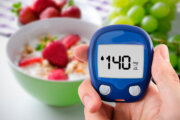There’s been plenty of debate about whether developing cancer is simply a matter of genetic bad luck and how much, if anything, changing your habits can affect risk. The latest entry: Researchers at Johns Hopkins published a paper this spring in the journal Science suggesting that roughly two-thirds of cancers are due to DNA typos — essentially, random errors. That’s a far cry from what a 2015 study found: that as many as 9 out of 10 cancers may be a result of environmental and lifestyle factors that could potentially be controlled. Still, the new findings are not an excuse to sit back and let fate take its course. The Hopkins researchers said some 40 percent of cancers can be avoided.
There are a number of lifestyle changes you can make to affect your cancer risk — and, as an additional benefit, also reduce the odds of diabetes and heart disease. Below are eight suggestions on how to protect yourself that are supported by recent science. One not included: smoking, which pretty much everybody should know by now “is probably the single most important risk factor” for most types of cancer, never mind its effect on the respiratory system, says Dr. Edward Giovannucci, a professor of nutrition and epidemiology at Harvard’s T.H. Chan School of Public Health who has published several studies on risk.
[See: The 12 Best Heart-Healthy Diets.]
Moderate your alcohol intake. According to the American Institute for Cancer Research, there’s “convincing evidence” that alcohol increases the risk of several types of cancer, including mouth, liver, breast and — at least in men — colorectal. In 2016, a British expert advisory group examined data since 1995 and concluded that there was strong evidence that the risk of a range of cancers, including breast, increased directly in line with consumption of alcohol.
It’s really excessive consumption that you need to worry about, experts say. Current recommendations call for no more than one drink a day for women and two for men. “If you want to make your risk zero, it should be zero intake,” Giovannucci says. “But increased risk is pretty minimal with one to two drinks.”
And of course, consider that a little bit of alcohol may have a cardioprotective effect — resveratrol, an antioxidant found in red wine, is particularly good at vacuuming up chemicals responsible for causing blood clots.
Limit sweets. “Sugar really has extreme adverse effects on human physiology,” warns Patricia Thompson, the deputy director for research at Stony Brook University Cancer Center. For one, it contributes to obesity, which fosters widespread inflammation, and that puts various organ systems at risk of disease.
Unlike the inflammation of, say, a wound, the chronic or systemic kind has been linked to everything from bloating and acne to heart attacks, Alzheimer’s and cancer. Excess sugar also is thought to negatively affect metabolism and the population of bacteria in your gut. Unbelievable as it may seem, what goes on in your “gut microbiome” is “really, really important” to the proper functioning of the body’s primary defense against tumors, the immune system, says Thompson, whose own research focuses on cancers of the colorectum as well as the breast. And sugar increases insulin levels, a risk factor for diabetes and for colon cancer.
Add resistant starch. This type of starch — good sources include legumes, bananas (the less ripe, the better), rolled oats and boiled potatoes that have cooled, as in potato salad — resists digestion, meaning it hasn’t broken down by the time it passes through the small intestine and provides nutrition to those important bacteria.
Researchers are still trying to pinpoint how diet changes the microbiome, but they do know that when you feed certain bacteria, they release a variety of good-for-you compounds, including butyrate, which “knocks off cancer cells,” says Michael Michael, a scientist at the Flinders Centre for Innovation in Cancer in Adelaide, Australia. In one of his studies, volunteers consumed 300 grams (roughly 10 ounces) of red meat a day, plus 40 grams of a powdered form of resistant starch mixed into orange juice. Normally the levels of a small group of microRNAs associated with cancer would go up with that kind of extreme meat-eating, but the starch brought almost all of the levels back to baseline. “That shows that at a molecular level this protects you against elevated cancer risk,” Michael says. As a bonus, studies suggest resistant starch can also help lower blood sugar and boost gut health.
Scale back on red meat. And when you eat it, marinate it. Besides being a heart-healthy move, cutting back may offer protection against cancer. One of the links between red meat and cancer that researchers are investigating involves heme, an iron-containing compound that has been shown to damage the lining of the bowel.
Why should you marinate? Cooking meat at high temperatures produces compounds that cause potentially harmful changes in your DNA. Various herbs, spices, and marinades have been shown to block the formation of cancer-causing compounds. A Kansas State University study, for example, found that rubbing rosemary onto uncooked meat reduced the compounds by 30 to 100 percent.
Limit processed meat. Or better yet, cut it entirely. The International Agency for Research on Cancer, a group of international experts who scrutinize the evidence, has classified processed meat as carcinogenic to humans, putting it in the same category as tobacco smoking and asbestos. (This doesn’t mean they’re equally dangerous; classifications are based on the strength of evidence, not the risk level.) Researchers think substances used in the processing may create cancer-causing compounds. And nitrites, which are used as preservatives, may also form compounds that damage DNA.
One fringe benefit of cutting down on these types of meats is that it will help curb your salt intake, a step that could lessen your risk of heart disease, stroke and stomach cancer. Most people eat more than the World Health Organization-recommended maximum of 5 grams per day. A 2017 Tufts University study found that a global drive to cut salt intake by 10 percent would save millions of lives currently lost to cardiovascular disease. In the U.S., a different study found, consuming too much salt was associated with 9.5 percent of deaths from heart disease, stroke and Type 2 diabetes.
[See: 10 Ways to Lower Your Risk of Stroke.]
Do more cardio. Centers for Disease Control and Prevention guidelines call for 150 minutes of moderate exercise — or 75 minutes of vigorous exercise — per week. These are aimed at heart health, but also may have a protective effect against 13 types of cancer, according to a 2016 review of studies published in JAMA Internal Medicine. The review found that working out for just a couple of hours a week appeared to shrink the risk of breast, colon and lung cancer, among others. The more you exercise, the greater the benefit, the study suggested.
Activities that result in sustained increases in heart rate tend to burn the most calories and help people maintain their weight. One particularly efficient activity: high-intensity interval training (story, Page 89). Besides burning calories, it also burns fat and boosts metabolism.
In addition, physical activity is thought to lower levels of hormones such as estrogen that have been linked to different cancers. And people who work out have been shown to have lower levels of systemic inflammation, with some evidence suggesting that physical activity boosts the capacity of cells to repair damaged DNA. Exercise also has an effect on metabolism as well as the health and function of the gut microbiome.
Keep in mind that a brisk walk counts as exercise. In fact, a walk actually is as good as a run for cutting risk of heart disease, according to a 2013 study published in the journal Arteriosclerosis, Thrombosis and Vascular Biology.
Get at least seven hours of sleep. Sleep is the body’s opportunity to do its repair work, but beyond that, disease researchers are particularly interested in the metabolic changes a sleep deficit creates. You’ve probably seen headlines to the effect that lack of sleep can make you fat — and your adipose tissue doesn’t just sit there innocently. It contains hormones and vitamin D that are needed for energy balance. Loss of sleep can change some of the mechanisms underpinning a healthy hormone and energy balance, creating conditions that can lead to insulin resistance. That state, which impedes the body’s ability to regulate glucose levels, may contribute to chronic inflammation and is a significant risk factor for developing Type 2 diabetes — itself a major risk factor for heart disease or stroke because excess glucose damages the arteries.
Moreover, chronic inflammation can put stress on the cells and interfere with normal cellular maintenance, so that “an event that would never have become a problem may move a line of healthy cells into a precancerous stage,” says Linda Nebeling, the deputy associate director of the National Cancer Institute’s Behavioral Research Program.
Keep an eye on your Vitamin D. You could say that Vitamin D, which is created when ultraviolet rays hit your skin, is having a moment in the sun. In 2016 alone, nearly 5,000 studies suggested its myriad health benefits. Aids the immune system! Maintains cognitive function! Reduces risk of cancer, heart attacks, MS and Type 2 diabetes! Helps you lose weight! Not bad for a vitamin whose earlier claim to fame was all about bone health: When D levels are too low, the body can’t effectively absorb calcium. Vitamin D plays a role in cell growth, particularly in how cells divide and multiply. Giovannucci co-authored a 2014 study that found that cancer mortality decreased by up to 15 percent with Vitamin D supplementation. And Vitamin D receptors are widespread in brain tissue, suggesting that the vitamin may have a neuroprotective effect. Older adults with low levels of Vitamin D have four times the risk of cognitive impairment compared to those with adequate levels.
One problem: While there’s strong observational data that Vitamin D is essential for good health and that people with low levels are at increased risk for several cancers, this is by association only — there could be another factor occurring with low vitamin D that explains the association, Thompson says. There’s also little consensus about how much you need, how you should get it, and exactly how many diseases it can help prevent. In writing 2010 guidelines on Vitamin D, recommending 600 IUs (international units) for adults, the Institute of Medicine considered only the amount needed for bone health: 20 nanograms per milliliter. To find out if you’re deficient, you’ll need a blood test.
[See: The 12 Best Diets to Prevent and Manage Diabetes.]
Under the right circumstances — tricky to nail down, because season, time of day, cloud cover and even pollution affect the amount of UVB that reaches your skin — a fair-skinned person needs roughly 15 minutes in the sun three times a week to generate sufficient Vitamin D. It’s tough to get Vitamin D from diet alone; a serving of fortified milk has just 100 IU.
That leaves supplements. If you go that route, look for Vitamin D3 instead of D2, because D3 is the compound you’d make from sun exposure, Giovannucci says. (He takes just one supplement himself: Vitamin D.) Most multivitamins contain 400 IU, a good start.
More from U.S. News
How Fit Are You? Consider These 6 Measures
7 Major Gaps in Women’s Health Research
How to Avoid a Second Heart Attack
Do-It-Yourself Prevention: Cut Your Cancer Risk originally appeared on usnews.com







